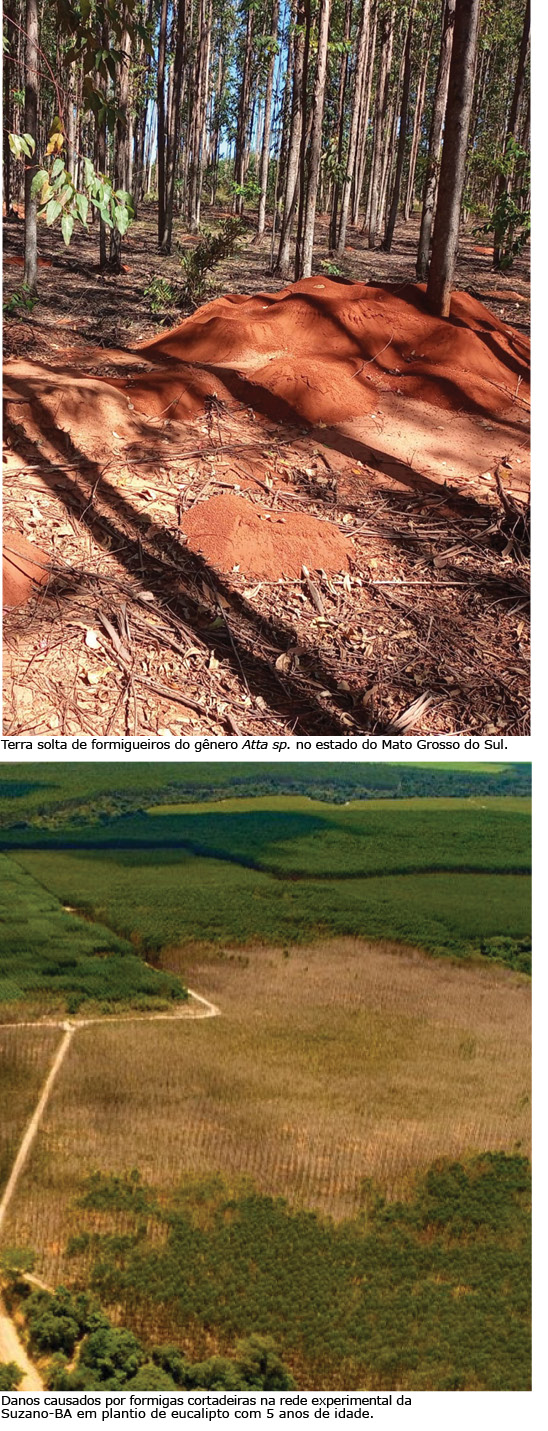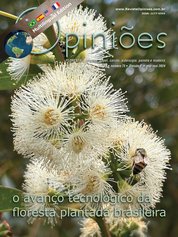Everton Pires Soliman e Maurício Magalhães Domingues
Forest Health and Protection Manager and Entomologist, from Suzano, respectively
OpCP75
Management, monitoring and control of leafcutter ants
Eucalyptus plantations are frequently attacked by pests, diseases and weeds, which represent a significant threat to the health and productivity of the trees. Pests can compromise the healthy growth of crops and even lead to their partial or total loss.
 Among the various pests that affect eucalyptus plantations, leaf-cutter ants stand out as the most harmful and challenging to manage. Leaf-cutter ants, belonging to the genera Acromyrmex and Atta, are considered the main pests of eucalyptus plantations in Brazil. These ants live socially in highly organized colonies, made up of thousands of individuals, and have an efficient communication system that makes them capable of mobilizing quickly in search of food.
Among the various pests that affect eucalyptus plantations, leaf-cutter ants stand out as the most harmful and challenging to manage. Leaf-cutter ants, belonging to the genera Acromyrmex and Atta, are considered the main pests of eucalyptus plantations in Brazil. These ants live socially in highly organized colonies, made up of thousands of individuals, and have an efficient communication system that makes them capable of mobilizing quickly in search of food.
Ant damage is significant to eucalyptus plantations, and can be observed by cutting tree leaves. These leaves are taken into underground nests, where they are used to cultivate a fungus that serves as food for the colony. Frequent leaf cutting compromises the healthy growth of trees, reducing their photosynthesis capacity and resulting in losses in productivity.
Research conducted by Suzano in Bahia revealed that areas with leaf-cutter ant infestations with 1,434 square meters of loose land per hectare had estimated reductions of 40 to 60% in forest volume. In severe cases, successive attacks by this pest can lead to the death of trees, resulting in significant economic losses. The severity of the attack is greater in younger plantations, but the pest can cause death at any age.
Integrated pest management is an approach that aims to control leaf-cutter ant populations effectively and sustainably, rationally using available control techniques. Regular detection and monitoring of leaf-cutter ant populations is essential to assess the severity of the problem and guide control strategies. This can be done through visual inspections of plantations, identifying nests and observing ant activity patterns.
When monitoring leaf-cutter ants, whether by direct or indirect sampling, the size of the anthill is estimated in square meters. This makes it possible to calculate the area occupied by the anthill, expressed in "square meters of loose soil" within the sampled area in hectares. The incidence (quantity) and severity (size of the anthills) are essential information for monitoring the pest. The area is estimated by measuring the nest in its two largest opposite directions, considering as part of the same nest the piles of loose earth that are up to 2 meters (2 steps) from each other.
To survey the anthill area (square meters of loose soil), one to two annual surveys are scheduled, at intervals of 6 months. The traceability of the survey generates the reliability that the person actually went to the field and carried out the transect. Data from Suzano experiments and consolidated data from the academy are used to eventually correct the size of the nests, estimating their future growth.
All information collected at Suzano is made available in management panels at a glance, containing monitoring planning (completed, discarded, pending and canceled), monitoring results and recommended control methods, as well as the detailed infestation history (average square meters per hectare of loose anthill land, number of anthills of saúva and quenquém per hectare, predominant species, distribution of infestation and intensity of damage).
From monitoring, we can make decisions that consider the infestation of the area, size of the largest leaf-cutter ant nest, location of the attack (edge or internally) and activity of the anthills. This information is essential to indicate whether or not it is the ideal combat season. Operational alert must be constant to avoid production losses, especially in new plantations.
Regardless of the form of monitoring, the fight must occur if the infestation reaches the level of control that can be adjusted according to the environment, productivity potential, among other details. At Suzano, a control level of 10 meters of loose soil per hectare or size of the largest nest is currently adopted: if an anthill with 10 meters of loose soil is detected, control will be recommended due to its rapid growth after this phase and capacity of causing damage.
Among the techniques for controlling leaf-cutter ants, each with its advantages and limitations, we have ant baits, the most commonly used control that consists of citrus pulp attractants with insecticides for the ants, which can be applied manually or mechanized. Liquid combat involves the direct application of insecticides with a jet aimed at the soil, and use only after the area has dried out, without the presence of flowers of any plant (eucalyptus and weeds).
The thermofogger, equipment that produces a fine mist of insecticide, allows effective control application in large nests that are difficult to control, but is difficult to operate when compared to bait and liquid. Formicidal powder can also be used by dusting the nests, but the technique is only effective for small nests (less than 1 square meter). Tests with baits and alternative products have not proven effective so far, although in the literature there are several studies under laboratory conditions, in the field the situation is very different.
It is important to emphasize that the use of these techniques must be carried out with caution, following the recommendations of the product manufacturers and respecting the standards. Furthermore, it is essential to adopt integrated management practices that contribute to the prevention and control of leaf-cutter ants in the long term, aiming to guarantee the sustainability of eucalyptus plantations and the preservation of the environment.
Leaf-cutter ants are complex insects. The growth and expansion of the forestry sector in Brazil is dependent on pest control, as it limits planting, establishment and productivity. Several Brazilian researchers, notably Professor Terezinha Della Lucia from the Federal University of Viçosa, Professor Ronald Zanetti from the Federal University of Lavras, Professor Luis Carlos Forti from Unesp in Botucatu, Professor Odair Correa Bueno from Unesp in Rio Claro, Professor Carlos Wilcken from Unesp in Botucatu and Professor José Cola Zanuncio from the Federal University of Viçosa, have already worked and/or are working a lot with their teams to understand and develop ways to control the pest, however management is totally dependent on chemical control.
To date, there is no new technique available and validated in the country for large-scale use to control the pest. However, as mentioned, monitoring allows us to adopt different techniques at the right time, effectively and only in those planting locations where the pest has reached control level.




